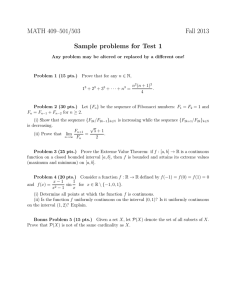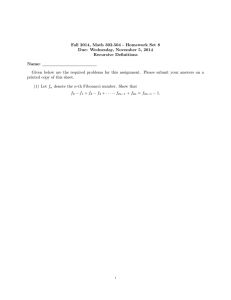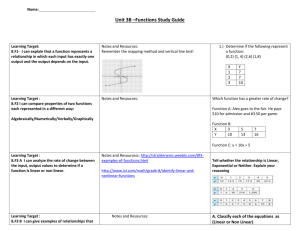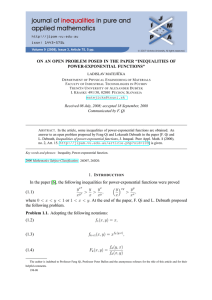Recursive Definitions & Induction Examples - Discrete Math
advertisement
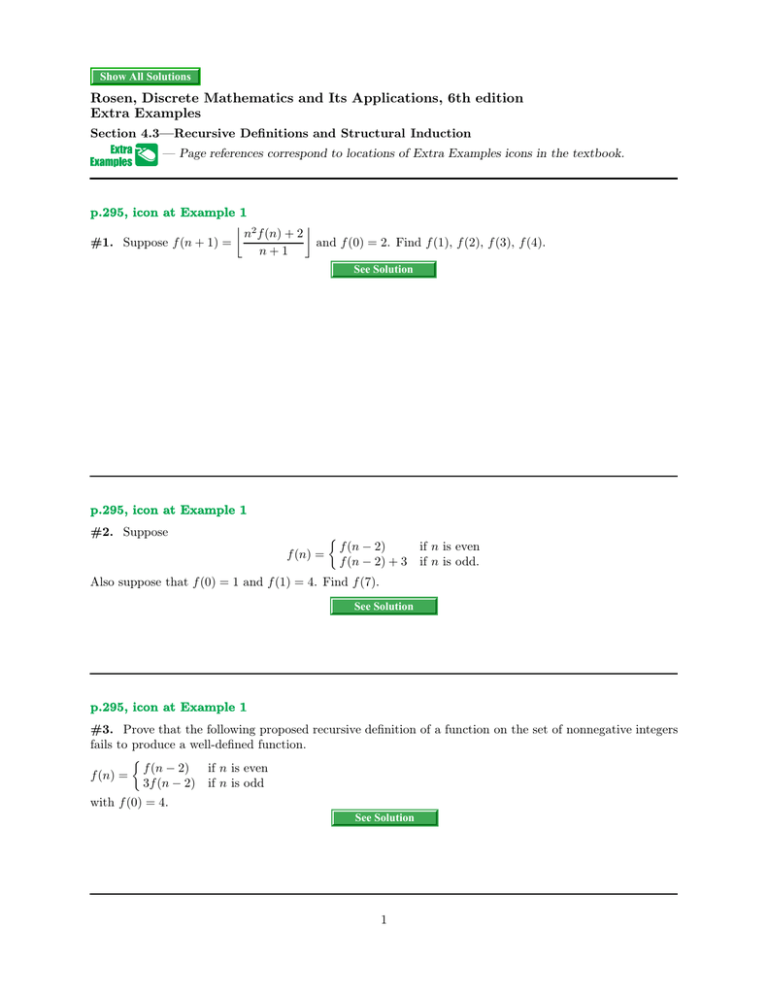
Show All Solutions
Rosen, Discrete Mathematics and Its Applications, 6th edition
Extra Examples
Section 4.3—Recursive Definitions and Structural Induction
— Page references correspond to locations of Extra Examples icons in the textbook.
p.295, icon at Example 1
2
n f (n) + 2
and f (0) = 2. Find f (1), f (2), f (3), f (4).
#1. Suppose f (n + 1) =
n+1
See Solution
2
0 ·2+2
2
02 f (0) + 2
=
=
= 2.
0+1
0+1
1
2
2
1 f (1) + 2
1 ·2+2
4
To find f (2), we use n = 1: f (2) = f (1 + 1) =
=
=
= 2.
1+1
1+1
2
2
2
2 f (2) + 2
2 ·2+2
10
To find f (3), we use n = 2: f (3) = f (2 + 1) =
=
=
= 3.
2+1
2+1
3
2
2
3 f (3) + 2
3 ·3+2
29
To find f (4), we use n = 3: f (4) = f (3 + 1) =
=
=
= 7.
3+1
3+1
4
Solution:
To find f (1), we use n = 0: f (1) = f (0 + 1) =
p.295, icon at Example 1
#2. Suppose
f (n) =
f (n − 2)
f (n − 2) + 3
if n is even
if n is odd.
Also suppose that f (0) = 1 and f (1) = 4. Find f (7).
See Solution
Solution:
Using the recurrence relation, we obtain f (3) = 7, f (5) = 10, and f (7) = 13.
p.295, icon at Example 1
#3. Prove that the following proposed recursive definition of a function on the set of nonnegative integers
fails to produce a well-defined function.
f (n − 2) if n is even
f (n) =
3f (n − 2) if n is odd
with f (0) = 4.
See Solution
Solution:
The value f (1) cannot be computed because f (1) = 3f (−1), but f (−1) is not defined.
1
p.295, icon at Example 1
#4. Prove that the following proposed recursive definition of a function on the set of nonnegative integers
fails to produce a well-defined function.
f (n) = f (f (n − 1)) + 5, f (0) = 1.
See Solution
Solution:
When we try to compute f (1), we obtain
f (1) = f (f (0)) + 5 = f (1) + 5,
which cannot happen.
p.297, icon at Example 6
#1. For the sequence of Fibonacci numbers f0 , f1 , f2 , . . . (0, 1, 1, 2, 3, 5, 8, 13, . . .), prove that
f0 + f2 + f4 + f6 + · · · + f2n = f2n+1 − 1
for all n ≥ 0.
See Solution
Solution:
Let P (n) be: f0 + f2 + f4 + f6 + · · · + f2n = f2n+1 − 1.
BASIS STEP: P (0) states that f0 = f1 − 1, which is true because f0 = 0 and f1 − 1 = 1 − 1 = 0.
INDUCTIVE STEP: P (k) → P (k +1): Suppose that P (k) is true; i.e., f0 +f2 +f4 +f6 +· · ·+f2k = f2k+1 −1.
We must show that f0 +f2 +f4 +f6 +· · ·+f2(k+1) = f2(k+1)+1 −1, i.e., f0 +f2 +f4 +f6 +· · ·+f2k+2 = f2k+3 −1:
f0 + f2 + f4 + f6 + · · · + f2k + f2k+2 = (f0 + f2 + f4 + f6 + · · · + f2k ) + f2k+2
= (f2k+1 − 1) + f2k+2
= f2k+1 + f2k+2 − 1
= f2k+3 − 1.
p.297, icon at Example 6
#2. For the sequence of Fibonacci numbers f0 , f1 , f2 , . . . (0, 1, 1, 2, 3, 5, 8, 13, . . .), prove for all nonnegative
integers n:
f02 + f12 + f22 + · · · + fn2 = fn fn+1 .
See Solution
Solution:
Let P (n) be the proposition
f02 + f12 + f22 + · · · + fn2 = fn fn+1 .
BASIS STEP: P (0) is the proposition f02 = f0 f1 . It is true because f02 = 02 = 0 and f0 f1 = 0 · 1 = 0.
INDUCTIVE STEP: Suppose P (k) is true. Then
f02 + f12 + f22 + · · · + fk2 = fk fk+1 .
2
2
2
We need to show that P (k + 1) is true: f02 + f12 + f22 + · · · + fk+1
= fk+1 fk+2 . We take P (k) and add fk+1
to both sides of the equation, obtaining
2
2
= fk fk+1 + fk+1
(f02 + f12 + f22 + · · · + fk2 ) + fk+1
= fk+1 (fk + fk+1 )
= fk+1 fk+2
(using the Fibonacci sequence recurrence)
Therefore P (k + 1) follows from P (k).
Therefore, by the Principle of Mathematical Induction, P (n) is true for all nonnegative integers n.
p.300, icon at Example 7
#1. Give a recursive definition for the set S = {4, 7, 10, 13, 16, 19, . . .}.
See Solution
Solution:
The set can be written starting from 4 and adding 3 over and over.
BASIS STEP: 4 ∈ S.
RECURSIVE STEP: n ∈ S → n + 3 ∈ S.
3
